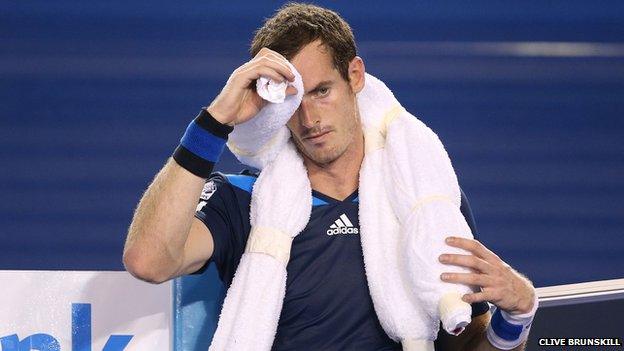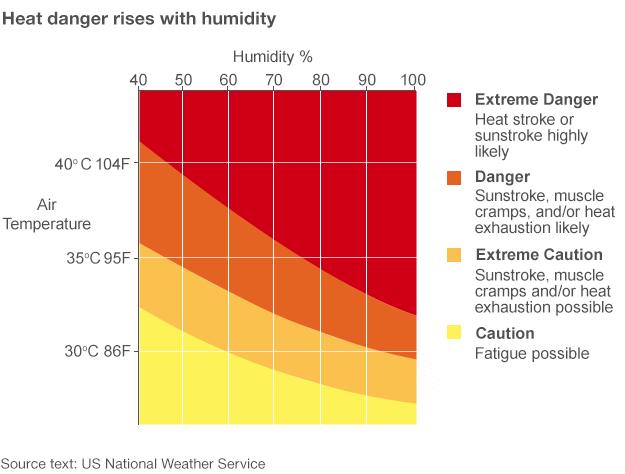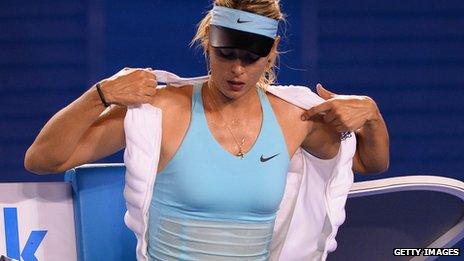Too hot for tennis? The impact of heat on players
- Published

Andy Murray cools himself down with an ice collar during his second-round match
As temperatures hit 43C at the Australian Open in Melbourne, officials decided it was just too hot to play tennis.
Play was suspended on all uncovered courts for more than four hours in the middle of the day because of extreme heat.
There is little doubt that people had been suffering in the sweltering conditions.
With readings in excess of 40C all week, ball boys were fainting, spectators wilting and players complaining of exhaustion and dehydration.
So what impact is the heat having on their bodies?
It is not surprising that by running around a tennis court for several hours in extremely dry conditions, players were generating a lot of heat.
Sweating not enough
According to Prof George Havenith, professor of environmental physiology and ergonomics from Loughborough University, players will be producing the heat equivalent of around 20 60W light bulbs.
When the effects of direct sunshine and radiation from the court surface are taken into consideration, as well as heat from the spectators watching and the lack of air flow around the court, this could increase the heat count by up to another 50%.
The key to coping with this level of heat production is losing it again through sweating.
"In Melbourne that's possible because it's dry, unlike a tropical country where the humidity is high. So it's easier to evaporate sweat.

"Players can cool down but it takes a lot of sweat to achieve it," Prof Havenith explains.
He calculates that tennis players in Melbourne this week, where the relative humidity is 20-22%, would need to lose between 1.5 and 2.5 litres of sweat an hour from their bodies in the current temperatures.
Yet the maximum someone can drink in that time is around one litre, so there is inevitably going to be a deficit of fluids in the body, particularly during a long match lasting several hours.
As a result, players can feel light-headed, weak and nauseous and start complaining of headaches and muscle cramps.
These are the signs of heat exhaustion, external, which occurs when the body loses excess fluids and salts due to hot temperatures.
Usually, the body slows down automatically when it reaches a temperature of 39C or 40C, in response to dehydration and feelings of exhaustion.
But elite athletes can push through this stage, and that's when they face the much more serious condition of heatstroke, external - which is a medical emergency.
At that point the body is no longer able to cool itself and starts to dangerously overheat. Although heatstroke can manifest itself differently in every individual, the most important sign of the condition is confusion.
Prof Havenith says: "When a person becomes disorientated, when they are not responsive any more, that's when they are getting close to their limits."
Cold start
To give themselves the best chance of coping with a match in the Melbourne midday sun, tennis players should be preparing their body beforehand.
Pre-cooling is now a common practice, which can mean a cold shower or ice bath before playing and the intake of lots of cold drinks in the run-up to a match to help maintain hydration levels.

Maria Sharapova puts on an ice vest during her lengthy match
Even eating cold foods, with a high water content, and avoiding hot meals can help, experts say.
Ice collars - ice packs wrapped up in towels to be hung round the neck - and ice vests have become regular sights this week at the Australian Open - for good reason.
The best method of cooling people down is to apply ice to areas where crucial arteries are located, like the groin and armpits. This helps to cool the blood quickly and increases blood flow to the muscles in the body.
Afterwards, Prof Havenith recommends cooling the hands and feet in ice water rather than the more drastic full immersion in an ice bath because, "it does not have such a sudden impact on the cardiovascular system".
Most important is replenishing the body's fluids by drinking water all day long. Drinks containing glucose and electrolytes, sodium and potassium salts, can also help this process.
In the end, players will just have to keep their fingers crossed for an air-conditioned match in a covered court - and pray they won't meet Rafa Nadal.
- Attribution
- Published16 January 2014
- Attribution
- Published16 January 2014
- Attribution
- Published23 July 2013
- Published18 July 2013
- Published20 July 2013